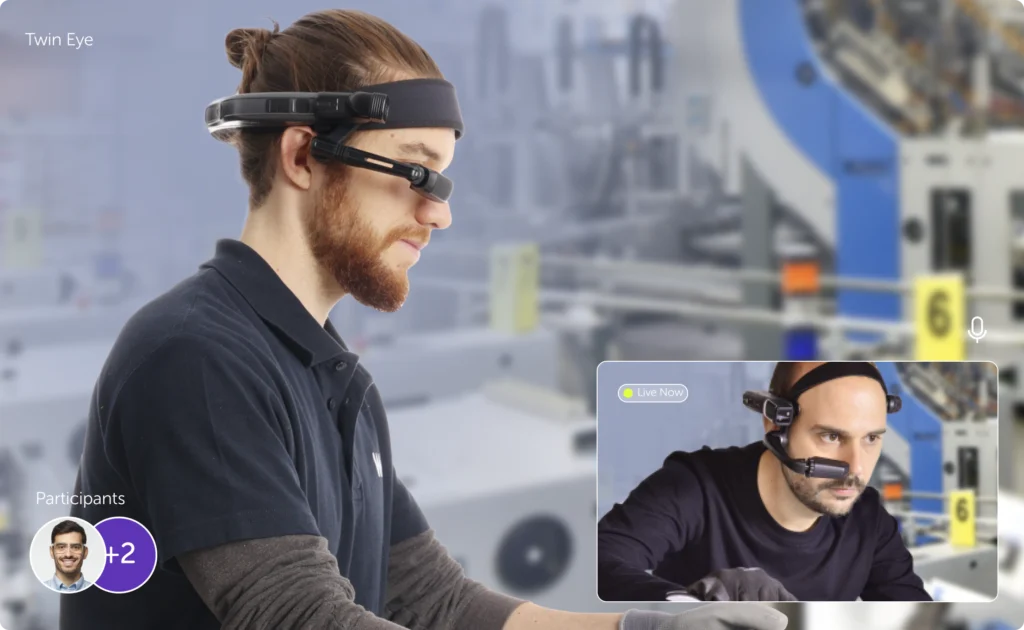Gli occhiali intelligenti si sono evoluti in modo significativo sin dal loro inizio, passando da tecnologia sperimentale a strumenti pratici ampiamente utilizzati in vari settori. Il concetto è iniziato negli anni ’60 con il lavoro pionieristico di Ivan Sutherland sui display montati sulla testa, gettando le basi per sviluppi futuri. Nei primi anni 2000, aziende come Google con i suoi Google Glass miravano a portare gli occhiali intelligenti sul mercato dei consumatori, ma è stato nelle applicazioni industriali che gli occhiali intelligenti hanno trovato un interesse sostanziale.
Applicazioni industriali e assistenza remota degli occhiali intelligenti
L’integrazione degli occhiali intelligenti nell’industria è stata trasformativa, in particolare con l’avvento del software di assistenza remota. Questa tecnologia consente la collaborazione in tempo reale tra lavoratori sul campo ed esperti remoti, migliorando significativamente l’efficienza operativa e la sicurezza.
Collaborazione in tempo reale: gli occhiali intelligenti consentono ai tecnici sul campo di connettersi con esperti remoti tramite streaming video in diretta, consentendo assistenza a mani libere. Questa capacità è fondamentale in ambienti complessi in cui sono necessarie entrambe le mani per eseguire attività ricevendo al contempo una guida visiva e verbale.
Trasferimento di conoscenze e formazione: gli occhiali intelligenti facilitano il trasferimento di conoscenze da lavoratori esperti a principianti. Ad esempio, ENGIE ha utilizzato gli occhiali intelligenti Iristick per formare giovani tecnici, consentendo loro di ricevere consigli in tempo reale da esperti esperti durante le operazioni sul campo. Questo approccio non solo riduce i periodi di formazione, ma preserva anche preziose conoscenze tacite.
Manutenzione e risoluzione dei problemi: in settori come la produzione, l’energia e l’assistenza sanitaria, le lenti intelligenti dotate di software di assistenza remota semplificano i processi di manutenzione e risoluzione dei problemi. Aziende come KUKA e Amazon hanno sfruttato questa tecnologia per ridurre i tempi di fermo macchina e migliorare l’efficienza del servizio. I tecnici possono diagnosticare e risolvere i problemi più rapidamente consultando esperti remoti senza dover effettuare lunghi viaggi.
Efficienza operativa: la capacità di fornire supporto remoto riduce i costi e i tempi di viaggio, riduce al minimo le emissioni di carbonio e consente agli esperti di fornire assistenza in più sedi in un solo giorno. Ad esempio, il software Remote Eye di Wideum aiuta aziende come Comexi e Syngenta a eseguire ispezioni e attività di supporto da remoto in modo efficiente, migliorando la produttività complessiva.
Sicurezza e accessibilità: gli occhiali intelligenti migliorano la sicurezza consentendo operazioni in aree pericolose o difficili da raggiungere. Durante la pandemia di COVID-19, ad esempio, l’assistenza remota ha consentito alle aziende di continuare le operazioni senza esporre i lavoratori a rischi per la salute. Questa tecnologia è preziosa anche nelle zone di conflitto o nelle regioni con severi requisiti per i visti, dove la presenza fisica è difficile.
Integrazione tecnologica e prospettive future degli occhiali intelligenti
Gli occhiali intelligenti oggi sono dotati di funzionalità avanzate come telecamere ad alta risoluzione, sovrapposizioni AR e riconoscimento delle immagini basato sull’intelligenza artificiale. Questi miglioramenti migliorano la qualità dell’assistenza remota e ampliano le potenziali applicazioni nel settore. Aziende come Wideum offrono piattaforme che integrano queste tecnologie, fornendo soluzioni robuste per la manutenzione remota, la condivisione di dati in tempo reale e applicazioni di realtà aumentata (AR).
Il futuro degli occhiali intelligenti in contesti industriali sembra promettente, in quanto continuano a evolversi. Con i continui progressi in AR e AI, gli occhiali intelligenti sono destinati a diventare ancora più parte integrante delle operazioni industriali, offrendo strumenti sofisticati per la collaborazione, la formazione e la manutenzione da remoto. Man mano che le industrie adottano sempre più strategie di trasformazione digitale, il ruolo degli occhiali intelligenti probabilmente si espanderà, guidando ulteriori innovazioni e miglioramenti dell’efficienza.
La storia e l’uso industriale degli occhiali intelligenti mostrano il loro impatto significativo sul miglioramento della produttività, della sicurezza e della condivisione delle conoscenze in vari settori. L’integrazione del software di assistenza remota è stata particolarmente fondamentale, consentendo la collaborazione in tempo reale e trasformando i paradigmi operativi tradizionali.

